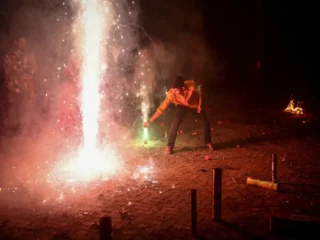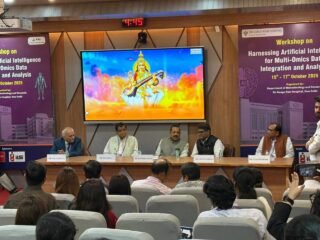Oil prices collapsed to more than two-decade lows Monday as traders grow concerned that storage facilities are reaching their limits, while equities were mixed, with some support coming from signs that the coronavirus may have peaked in Europe and the United States. US crude benchmark West Texas Intermediate briefly plunged almost 20 percent to below $15 — its lowest since 1999 — as stockpiles continue to build owing to a crash in demand caused by the COVID-19 pandemic. Analysts said this month’s agreement between top producers to slash output by 10 million barrels a day was having little impact on the oil crisis because of lockdowns and travel restrictions that are keeping billions of people at home. WTI was hit particularly hard as its main US storage facilities in Cushing, Oklahoma, were filling up. ANZ said “crude oil prices remained under pressure, as projections of weaker demand weigh on sentiment”. “Despite the OPEC+ alliance agreeing to an unprecedented cut in output, the physical market is awash with oil,” it said, referring to the Organization of the Petroleum Exporting Countries and non-OPEC partners. And AxiCorp’s Stephen Innes added: “It’s a dump at all cost as no one… wants delivery of oil, with Cushing storage facilities filling by the minute. “It hasn’t taken long for the market to recognise that the OPEC+ deal will not, in its present form, be enough to balance oil markets.” Stock traders were in slightly more buoyant mood as governments start to consider how and when to ease lockdowns that have crippled the global economy. Italy, Spain, France and Britain reported drops in daily death tolls and slowing infection rates. “We are scoring points against the epidemic,” said Prime Minister Edouard Philippe, while insisting “we are not out of the health crisis yet”. Meanwhile, in the US, Andrew Cuomo, governor of badly hit New York state, said the disease was “on the descent”, though he cautioned it was “no time to get cocky”.
The UN children’s agency appealed Monday for an additional $92.4 million to help fight the coronavirus pandemic in the Middle East and North Africa, a conflict-battered region with the highest number of children in need anywhere. Yemen is a top concern, said Ted Chaiban, the regional chief of UNICEF. After five years of civil war, half the health centers in Yemen no longer operate. Two million children are malnourished, including 400,000 who suffer from severe acute malnutrition. “If you don’t get support to them every month, you have a 50% increase in the mortality rate among those children (with severe malnutrition),” Chaiban told The Associated Press. “It was already critical to address the needs of children in Yemen. With COVID-19, now you’ve got this extra lawyer of vulnerability.” So far, there has only been one confirmed coronavirus patient in Yemen, but testing capabilities are limited and there are concerns the virus might be spreading undetected. More than 218,000 infections have been reported in the region, including close to 8,000 deaths, the vast majority of them in Iran. Chaiban said the additional funding is needed for a range of programs across the region to soften the blow of the pandemic. In addition to its regular nutrition and immunization services, the agency is helping to establish isolation centers and improve water and sanitation. UNICEF is also running awareness campaigns about social distancing and hygiene, which are particularly difficult in crowded neighborhoods and refugee camps, he said. Before the pandemic, some 25 million children in the region were in need of humanitarian aid.
Prime Minister Imran Khan on Monday urged the people of Pakistan to show “self discipline” and refrain from going outside to stem the spread of the novel coronavirus, which has killed nearly 170 and infected 8,516 people in the country. Prime Minister Khan’s remarks came days after he cautioned that Pakistan may see an increase in the number of coronavirus cases from mid-May and the healthcare system could come under significant pressure. “My message for people is to stay home as much as possible during this pandemic. The more people show self-discipline, the easier it will be for us to manage the COVID-19 plus ease the lockdown gradually,” he said in a tweet. According to health officials, Punjab has registered 3,822 COVID-19 cases, while 2,544 infections have been reported in Sindh, 1,235 in Khyber-Pakhtunkhwa, 432 in Balochistan, 263 in Gilgit-Baltistan, 171 in Islamabad and 49 in Pakistan occupied Kashmir. A total of 168 people have died from the disease in Pakistan. The Ministry of National Health Services has not updated its data so far.
A bright red robot at the district collectorate in Bulandshahar, Uttar Pradesh is helping people maintain social distancing and minimise spread of coronavirus by dispensing sanitiser to staff and visitors. Fitted with sensors, the robot detects human presence and dispenses sanitiser. Such robots will soon be deployed in hospitals in the district for giving food, water and medicines to patients to help reduce contact between healthcare workers and positive cases. “We have deployed a robot, made by local engineering students, at COVID-19 control room at the collectorate. The robot is used for giving sanitisers to employees and visitors, thereby avoiding human involvement in the job,” District Magistrate, Bulandshahr Ravindra Kumar told PTI. The robot, which has the capability to walk, can work for one to one-and-a-half hours at a stretch after which its battery needs to be recharged. As of now, it will dispense only sanitiser. “Presently, we have only one robot. But, we are facilitating the makers to buy spare parts so that they can deliver two more. Very soon, we will be using services of robots for giving food, water and medicines to patients in hospitals,” the DM said. These robots will not only help doctors and staff but also prevent them from direct contact, thus avoiding infections, he stressed. He said credit for the robot goes to local techies – Nishant Sharma and Atul Kumar – both pursuing engineering courses at separate private institutions in Noida. Sharma said, “When we came to know about the disease and the way it spreads, we thought of doing something. We made this robot after toiling for over a month.






